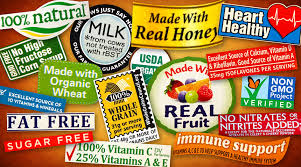
For most people, food shopping is at the bottom of the barrel for fun. Between the crowds at stores, the time it takes out of our day, and the skyrocketing prices; It’s one of the week’s dreaded chores. Throw in the marketing madness on the packaged foods and many well-intended shoppers are being ‘punked’ for that expensive bill at the register.
One of our biggest giggles is when we see “Gluten Free” on chicken and “Natural” on bacon sitting in a basket in the middle of the (unrefrigerated) store. How is the consumer to know what is what and when they can trust these labels?
Perhaps this table will help. Please pass it on 4 Better Health.
| Marketing label | What it means | Why we’re being ‘punked’ | Similar and confusing |
“Natural “
|
Contains no artificial ingredient or added color and one that is only minimally processed
The label must include a statement explaining the meaning of the term natural (such as “no artificial ingredients; minimally processed”) |
Product may contain antibiotics, hormones, High fructose corn syrup, and other similar chemicals.
The USDA lets the meat and poultry products claim to be “All Natural” when injected with beef or chicken broth, which not only increases the sodium levels but increases the price due to a higher weight.
The term is unregulated and undefined if not on a meat product |
“All” Natural = no difference |
“Fresh” |
Whole poultry and cuts that have never been below 26°F. A product that has been heated or cooked or more than minimally processed cannot be called “fresh” | Does not mean recently harvested, “close to the farm,” “from the farmers’ market,” or “from the garden” | Minimally processed: processed in a manner that does not fundamentally alter the product. Traditional processes including smoking, roasting or drying |
‘GMO”(Genetically Modified Organism) |